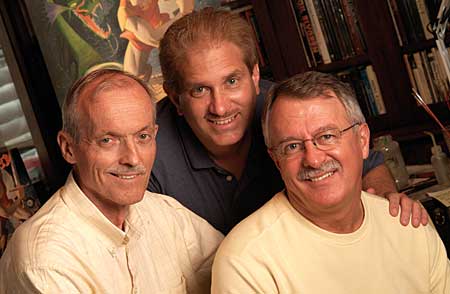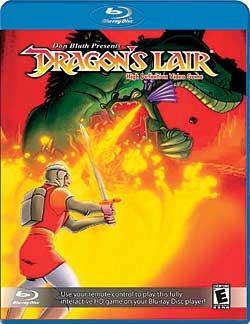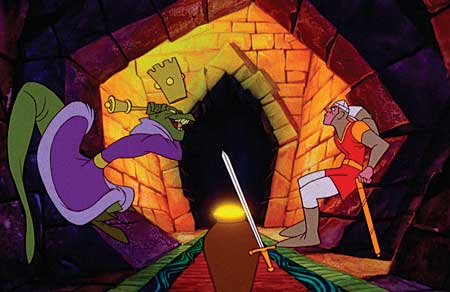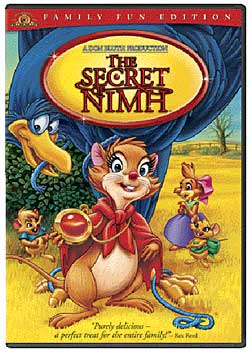HT Talks To... Don Bluth

Don Bluth (left) sitting with Rick Dyer (center) and Gary GolDman (right), his partners on the classic and surprisingly enduring video game Dragon's Lair.
How closely have you been involved with the Dragon's Lair game since you directed the animation for it?
Don Bluth: Actually, our company, Bluth Group Ltd., owns the rights and the copyrights to all three games and the characters—Dragon's Lair, Space Ace, and Dragon's Lair II: Time Warp—in partnership with Digital Leisure. Gary Goldman, John Pomeroy, and I were involved as executive producers on Dragon's Lair 3D: Return to the Lair. So, we stay fairly closely involved. However, my interest since producing those games back in the '80s has been directing feature animated films. In fact, we've been working on the script for a feature-length film for Dragon's Lair.
That's great news. So, for this new Blu-ray version, was your movie remastered from the original camera negative?
DB: Yes, Digital Leisure took the IP [interpositive] from the original negative and remastered it in HD. Then, they took the HD master back to their offices to digitally clean it up, removing scratches, dust, and other minutia to give the new presentation of the game a pristine, color-correct visual. They also updated the audio to a 5.1 Dolby format.
Paul Gold: The new high-definition optical-disc formats allowed us to go back to the original film negative and create a brand-new print that could be used to create a stunning high-def transfer. As Dragon's Lair was natively shot on film, it gave us the opportunity to give fans something really exciting and new. The all-new 5.1 surround sound mix was created by literally pulling apart the original sound to create the mix. Each scene was taken and individually remixed for the release, which is something that had never been done before on any other release.
 Beyond the improved picture quality, how in particular does this new version of Dragon's LAir take advantage of Blu-ray technology?
Beyond the improved picture quality, how in particular does this new version of Dragon's LAir take advantage of Blu-ray technology?
PG: Dragon's Lair utilizes the Blu-ray Disc Java, or BD-J, interactive platform, which supports advanced content for Blu-ray discs. BD-J coding allows control of the video, audio, and overlays using Java code, which makes Dragon's Lair one of the most sophisticated Blu-ray titles on the market.
Wasn't Dragon's Lair the first such arcade game of its kind, with an original, fully animated story line?
DB: I believe so. It was the first interactive game presented in movie-quality animation on laserdisc technology. It is said that the animation and the improved quality of the graphics in this game basically challenged the game industry to move forward or change. Dragon's Lair was a fresh, new look, with comedy, drama, and a basic story line.
Did you originally resist the notion of creating a movie, which requires so much work, strictly for video-game use?
DB: Not really. We didn't really understand the gaming possibilities with regard to the animation medium. We saw it as a great opportunity to expand the use of animation, especially movie-quality animation.
How did you come to voice the character Borf in Space Ace?
DB: The only professional, paid voice was that of the announcer for the attract mode on each game. In Space Ace, Dexter was voiced by animator/story man Will Finn, Ace was voiced by animator Jeff Etter, and Kimberly was voiced by animator Lorna Pomeroy (Cook). I thought, if they can do those voices, surely I could do Borf. I put on the gravelly voice, then we messed with it digitally for the final dub.

A Scene From Dragon's Lair
The game characters, particularly the ladies, are a bit more "grown up" than they are in your movies. Wouldn't you agree?
DB: Sure they are, but then we were playing to a more grown-up audience. Our movies are G or PG. The games could be PG-13.
As someone whose career goes back to the 1950s, what's your take on how digital technology has taken over—in animation, video games, and all home entertainment?
DB: It's the logical answer, especially for the interactivity. Traditional animation in video games is limited to a linear format—choices of moves or action only. For the movies, I think CG animation passes the test for teens, where traditional animation carries a stigma of a children's medium, although that never stopped adults from buying tickets. It's those pesky teens who feel like hand-drawn animation is for kids. The takeover is due to the high number of tickets sold versus tickets sold for a traditional animated film. However, a CG movie does cost a lot more, so it better sell more tickets. I believe that a traditional animated film of Dragon's Lair would break that mold and rescue hand-drawn animated films.
Can you comment on your time at Disney? It Was on again/off again, but you did some amazing work.
DB: Thank you. Gary Goldman, John Pomeroy, and I all enjoyed our time at Disney. We just felt that we had missed the golden age of animation between 1934 and 1966, the year of Walt's death. Things were just getting cheaper and cheaper. My first years there were in the mid-'50s. I was there for a year on Sleeping Beauty, as an assistant animator under John Lounsbery in '55 and '56. Then I worked summers as an assistant animator, I think on Beauty and then later on The Sword and the Stone. I didn't return to Disney until 1971, after a stint in musical theater and television animation.
 Your departure and subsequent success as an independent filmmaker was pretty unusual at the time.
Your departure and subsequent success as an independent filmmaker was pretty unusual at the time.
DB: Yes, it was a real leap of faith. I guess we were just three really inspired animators trying to revive what we thought was a dying art form.
As someone who wears so many hats, do you find one aspect of filmmaking most satisfying? The actual drawing, or. . .?
DB: I enjoy designing the characters. I enjoy working on the stories, even writing some of the scripts, but, most of all, I enjoy directing.
What's it like when a movie strikes a chord with audiences, especially when one goes on to become a 12-film (and counting) series like The Land Before Time?
DB: I'm not real big on sequels, but, when the audiences respond to the films, it is truly thrilling. Even if they cry, it's great when you touch their sensitivity.
- Log in or register to post comments




































































